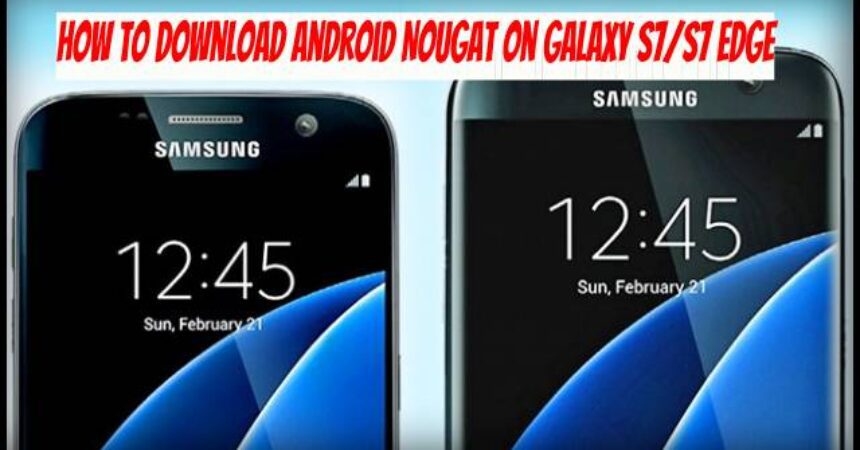Attention to all Samsung Galaxy S7 and S7 Edge owners – the highly anticipated Android 7.0 Nougat update has finally been released. After a series of beta tests, Samsung has officially begun rolling out the final version of Android 7.0 Nougat for both the Galaxy S7 and Galaxy S7 Edge. The firmware is now available on the internet, allowing you to download and install it on your phone right away, rather than waiting for the over-the-air update. Android 7.0 Nougat comes with numerous improvements, including enhanced performance, stability, and battery life for the S7 and S7 Edge. Additionally, there are several new features, as well as visually refreshing elements in the user interface.
The list of new features in Android 7 Nougat is extensive, but we’ll summarize it for you. Several phone applications have received updated color schemes, while Samsung has also made changes to the appearance of the battery indicator in the status bar. Additionally, app folders on the phone now have a transparent design. Another notable feature is the ability to adjust the screen resolution, which helps to conserve battery life. Furthermore, you can now add third-party applications to the quick toggles menu, among other enhancements. Overall, the firmware has seen significant improvements. As the firmware is now available on the internet, we can now safely explore the installation process.
Now, we will guide you through the step-by-step process of downloading and installing the official Android 7.0 Nougat on your Samsung Galaxy S7 and Galaxy S7 Edge. It is important to follow the instructions carefully in order to prevent any issues. Please note that the firmware provided below is authentic and unaltered. You can install these firmwares on your phone, regardless of your location. Simply ensure that your device model number matches, and you will be ready to proceed.
Firmware Information and Download
Galaxy S7 G930F and others
- Version: Android 7
- PDA: G930FXXU1DPLT
- MODEM: G930FOXA1DPLT
- Download Android 7 Nougat for G930F | Download Android 7 Nougat for Other Galaxy S7 Variants
Galaxy S7 Edge G935F and others
- Version: Android 7.0
- PDA: G935FXXU1DPLT
- MODEM: G935FXXU1DPLT
- Download Android 7 Nougat for G935F | Download Android 7 Nougat for Other Galaxy S7 Edge Variants
Initial Preparations
- Please verify that your device matches the model numbers mentioned above. To do this, go to Settings > More/General > About Device or Settings > About Device and compare the model number. Flashing a file on a device not listed here may result in permanent damage, known as “bricking.” We cannot be held responsible in such cases.
- Ensure that your device has a sufficient battery charge. If your device runs out of power during the flashing process, it may become softly bricked, requiring you to flash the stock firmware. This process will result in the deletion of your data.
- It is important to use the original data cable to connect your Android device to your computer or laptop. Using generic data cables may cause interruptions or errors during the flashing process. To ensure a smooth and successful flashing procedure, please adhere to this requirement.
- Back up all your data
Back up text conversations
Secure call records
Secure contact list
Manually transfer your media files to your PC or Laptop for creating a backup.
If your device is rooted, make sure to back up the EFS. Otherwise, you can skip this step.
- To avoid errors and connection issues, disable Samsung Kies, antivirus software, and firewall while using Odin3 flashtool.
Key Downloads & Installations
- On your PC, ensure that you download and install the Samsung USB Drivers.
- Please download and extract Odin3 v3.12.3.
- Extract the firmware file that you have downloaded in order to obtain the .tar.md5 files.
How to Download Android Nougat on Galaxy S7/S7 Edge – Guide
- Please ensure that you carefully review the instructions provided above and you are ready to proceed.
- To achieve a clean installation, perform a factory data reset by booting your device into recovery mode and wiping it entirely.
- Launch Odin3.exe.
- Enter download mode on your Galaxy S7 Edge by turning it off, waiting for 10 seconds, and then turning it on while simultaneously pressing and holding the Volume Down + Home Button + Power Key. You will see a warning message, press Volume Up to proceed. If this method does not work, refer to a guide for alternative methods.
- Establish a connection between your device and your PC.
- Once Odin detects your phone, you should notice that the ID:COM box turns blue.
- In Odin, proceed to select the files individually as depicted in the provided image.
- Choose the BL file within the BL tab.
- Within the AP tab, select the PDA or AP file.
- In the CP tab, choose the CP file.
- Within the CSC tab, select the HOME_CSC file.
- Verify that the options selected in Odin match the exact configuration as shown in the picture.
- Click on the “Start” button and patiently wait for the firmware flashing process to conclude. A green box will appear indicating successful flashing.
- After the firmware flashing process is successfully completed, disconnect your device and perform a manual reboot.
- After the device finishes booting up, you can now explore the updated firmware.
- Your device will now be operating on the official Android 7.0 Nougat firmware.
- After successfully updating to the stock firmware, it is important to note that attempting to downgrade may lead to complications with the EFS partition of your device. It is advisable to avoid downgrading to prevent any issues.
- That concludes the process.
Feel free to ask questions concerning this post by writing in the comment section below.






